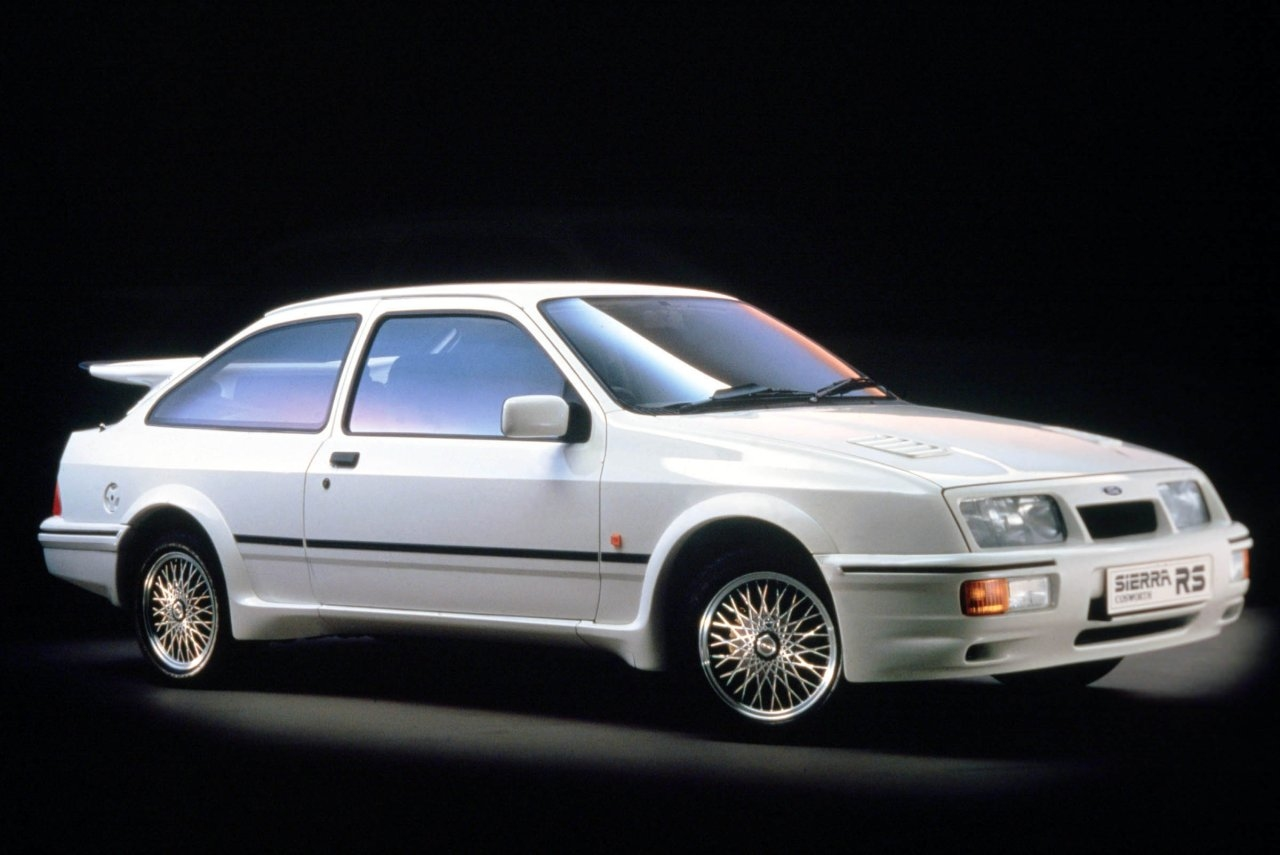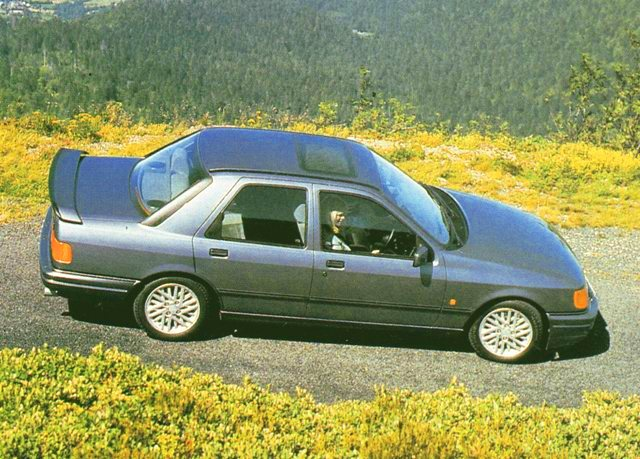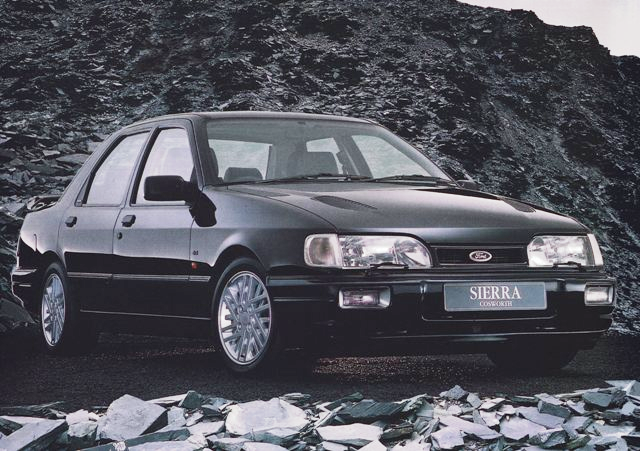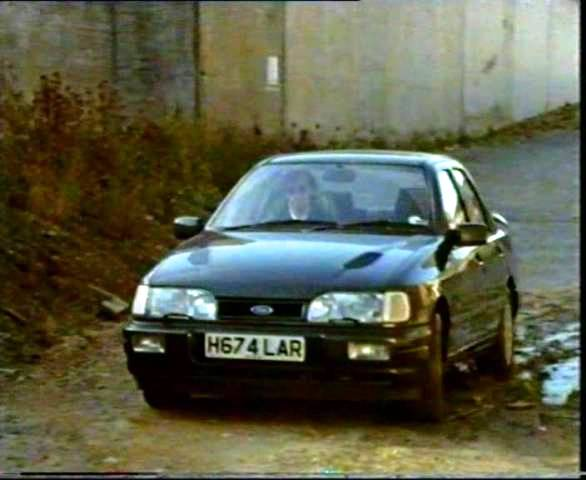RS Cosworth
| The Ford Sierra RS Cosworth was first unveiled at the Geneva Motor Show in March 1985 and caused quite a storm from the start! Available to buy in the UK from July 1986, the model utilised a 3-door hatchback body similar to the XR4i, but with a single rear side window in place of the XR's split design, it offered groundbreaking 150mph performance in a 'family' car. Powered by a 2.0 16-valve Cosworth YBB engine with Garrett T3 turbocharger, and driving the rear wheels through a Borg Warner T5 gearbox borrowed from the Mustang and a 7.5" limited-slip differential, it could sprint from 0-60 in 6.2 seconds - quick enough to shame most Italian supercars of the time. Outside the car had a full bodykit and the now infamous huge rear wing, necessary to provide downforce on the race track. The interior was trimmed with Recaro front seats and matching split-rears, retaining the Sierra practicality. 5,042 models were made in this form to comply with homologation rules, with a further 500 modified with the Cosworth YBD powerplant, a bigger T4 turbo, 8-injector manifold and various other changes necessary to homologate race parts. These 500 cars were badged “RS500” in commemoration, and although they had similar power in road trim to the 'ordinary' 3-door models they allowed their racing counterparts to be tuned to over 500bhp! The Sierra Cosworth RS500 dominated the British Touring Car Championship for three years from 1988-1990 even though the MK1 Sierra range was discontinued in 1987. | © Ford Motor Company 1986 |
|
© Motor Magazine 1988 |
With the launch of the 4-door saloon range in 1987, Ford made the decision to use this shell as the basis for a more discreet RS Cosworth to compete with the BMW M3 and was to be available in showrooms from January 1988. The 4-door model was named ‘Sierra Sapphire’ in the UK only, so was badged by Ford as a Sierra RS Cosworth. However, a discreet ‘Sapphire’ badge was added to the rear door window trims of cars destined for the UK market. Using the same YBB engine and running gear as the original 3-door Cosworth, performance was unchanged, but the exterior reflected the change in marketing: the Sapphire was sold as an "executive express" rather than a race car for the road. The full bodykit had gone in favour of some discreet sideskirts, a unique front bumper/airdam, and a much smaller boot spoiler similar to other sporting Sierra models, albeit with an extra lip. Numbers weren't limited this time either, with approximately 14,000 models being sold before it was superseded in 1990. |
|
The 4x4 model was the final incarnation of the Sierra RS Cosworth marque and was available to buy from March 1990. Externally there was little to tell it apart from the previous RWD model with the only giveaways being the return of bonnet-vents, clear front lenses, smoked rear lenses and discreet '4x4' wing badges. However, under the skin it was very different. Cosworth had uprated the engine to 220bhp to counter the increased drag and weight of the drivetrain, which was identical to the XR4x4 model in using Ford's own MT75 gearbox and Ferguson 4WD system [see XR4x4 page]. Two engines were available; the YBJ which ran on leaded or unleaded petrol and featured the familiar red cam cover of the previous models, and the green-topped YBG fitted with a catalytic converter to run on unleaded petrol only to comply with tighter emissions regulations in overseas markets. Although externally looking very similar to the YBB, 80% of the engine parts were new or re-engineered and included a stronger cylinder block and stiffened cylinder head. The 4-pot front brake callipers of previous models also vanished, along with the 7.5" rear diff in favour of the standard 7" item common to the other 4WD Sierras. Performance was near identical to the RWD model despite the weight penalty, and only minor interior changes set them apart, the most notable being the option of leather trim at an extra £500 on top of the £24,995 sticker price. Between February and July 1990, over 5,000 cars were produced in time for the 1st August 1990 sporting homologation deadline and sales were brisk. A final minor facelift of all the Sierra range in 1991 brought some changes in available paint colours and a different dash design, plus the alloy wheels also changed at this point from the familiar lattice type to a criss-cross design. The Sapphire RS Cosworth 4x4 model was produced in this form until its discontinuation in December 1992 with approximately 12,000 examples sold. Both the 2WD and 4x4 versions enjoyed success in motorsport and became well known in the UK as the car driven by Jimmy Nail in his early 90s BBC detective series ‘Spender’. Pictured right is the big man himself behind the wheel of the RS Cosworth 4x4 used in the second series. |
© Ford Motor Company 1991 © BBC
TV & Big Boy Productions 1992 |
|
© Sprintex-net 2011 - Go to Sprintexnet home



